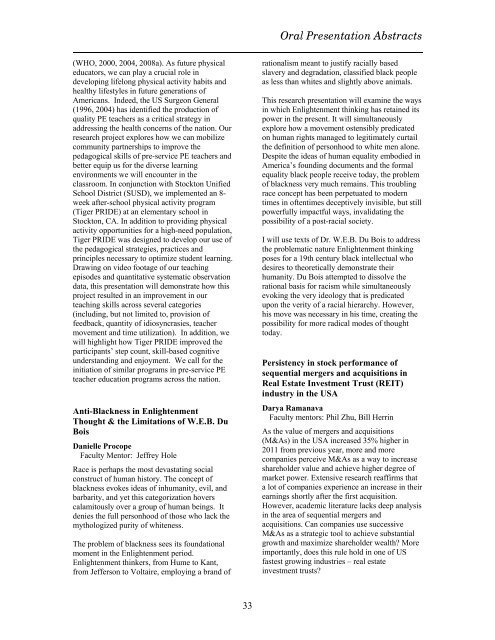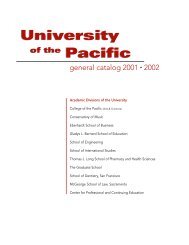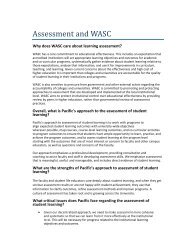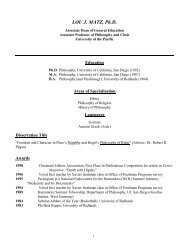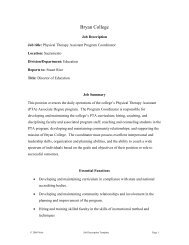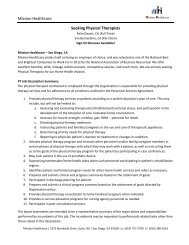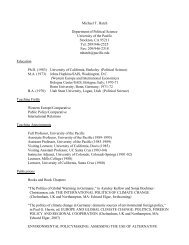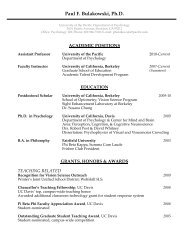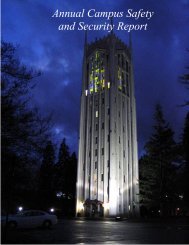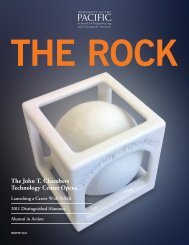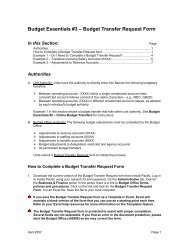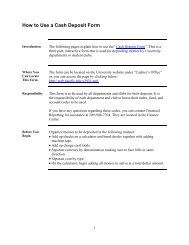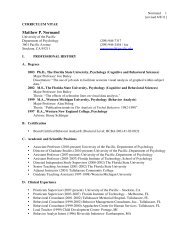purcc 2012 - University of the Pacific
purcc 2012 - University of the Pacific
purcc 2012 - University of the Pacific
Create successful ePaper yourself
Turn your PDF publications into a flip-book with our unique Google optimized e-Paper software.
Oral Presentation Abstracts<br />
(WHO, 2000, 2004, 2008a). As future physical<br />
educators, we can play a crucial role in<br />
developing lifelong physical activity habits and<br />
healthy lifestyles in future generations <strong>of</strong><br />
Americans. Indeed, <strong>the</strong> US Surgeon General<br />
(1996, 2004) has identified <strong>the</strong> production <strong>of</strong><br />
quality PE teachers as a critical strategy in<br />
addressing <strong>the</strong> health concerns <strong>of</strong> <strong>the</strong> nation. Our<br />
research project explores how we can mobilize<br />
community partnerships to improve <strong>the</strong><br />
pedagogical skills <strong>of</strong> pre-service PE teachers and<br />
better equip us for <strong>the</strong> diverse learning<br />
environments we will encounter in <strong>the</strong><br />
classroom. In conjunction with Stockton Unified<br />
School District (SUSD), we implemented an 8-<br />
week after-school physical activity program<br />
(Tiger PRIDE) at an elementary school in<br />
Stockton, CA. In addition to providing physical<br />
activity opportunities for a high-need population,<br />
Tiger PRIDE was designed to develop our use <strong>of</strong><br />
<strong>the</strong> pedagogical strategies, practices and<br />
principles necessary to optimize student learning.<br />
Drawing on video footage <strong>of</strong> our teaching<br />
episodes and quantitative systematic observation<br />
data, this presentation will demonstrate how this<br />
project resulted in an improvement in our<br />
teaching skills across several categories<br />
(including, but not limited to, provision <strong>of</strong><br />
feedback, quantity <strong>of</strong> idiosyncrasies, teacher<br />
movement and time utilization). In addition, we<br />
will highlight how Tiger PRIDE improved <strong>the</strong><br />
participants’ step count, skill-based cognitive<br />
understanding and enjoyment. We call for <strong>the</strong><br />
initiation <strong>of</strong> similar programs in pre-service PE<br />
teacher education programs across <strong>the</strong> nation.<br />
Anti-Blackness in Enlightenment<br />
Thought & <strong>the</strong> Limitations <strong>of</strong> W.E.B. Du<br />
Bois<br />
Danielle Procope<br />
Faculty Mentor: Jeffrey Hole<br />
Race is perhaps <strong>the</strong> most devastating social<br />
construct <strong>of</strong> human history. The concept <strong>of</strong><br />
blackness evokes ideas <strong>of</strong> inhumanity, evil, and<br />
barbarity, and yet this categorization hovers<br />
calamitously over a group <strong>of</strong> human beings. It<br />
denies <strong>the</strong> full personhood <strong>of</strong> those who lack <strong>the</strong><br />
mythologized purity <strong>of</strong> whiteness.<br />
The problem <strong>of</strong> blackness sees its foundational<br />
moment in <strong>the</strong> Enlightenment period.<br />
Enlightenment thinkers, from Hume to Kant,<br />
from Jefferson to Voltaire, employing a brand <strong>of</strong><br />
rationalism meant to justify racially based<br />
slavery and degradation, classified black people<br />
as less than whites and slightly above animals.<br />
This research presentation will examine <strong>the</strong> ways<br />
in which Enlightenment thinking has retained its<br />
power in <strong>the</strong> present. It will simultaneously<br />
explore how a movement ostensibly predicated<br />
on human rights managed to legitimately curtail<br />
<strong>the</strong> definition <strong>of</strong> personhood to white men alone.<br />
Despite <strong>the</strong> ideas <strong>of</strong> human equality embodied in<br />
America’s founding documents and <strong>the</strong> formal<br />
equality black people receive today, <strong>the</strong> problem<br />
<strong>of</strong> blackness very much remains. This troubling<br />
race concept has been perpetuated to modern<br />
times in <strong>of</strong>tentimes deceptively invisible, but still<br />
powerfully impactful ways, invalidating <strong>the</strong><br />
possibility <strong>of</strong> a post-racial society.<br />
I will use texts <strong>of</strong> Dr. W.E.B. Du Bois to address<br />
<strong>the</strong> problematic nature Enlightenment thinking<br />
poses for a 19th century black intellectual who<br />
desires to <strong>the</strong>oretically demonstrate <strong>the</strong>ir<br />
humanity. Du Bois attempted to dissolve <strong>the</strong><br />
rational basis for racism while simultaneously<br />
evoking <strong>the</strong> very ideology that is predicated<br />
upon <strong>the</strong> verity <strong>of</strong> a racial hierarchy. However,<br />
his move was necessary in his time, creating <strong>the</strong><br />
possibility for more radical modes <strong>of</strong> thought<br />
today.<br />
Persistency in stock performance <strong>of</strong><br />
sequential mergers and acquisitions in<br />
Real Estate Investment Trust (REIT)<br />
industry in <strong>the</strong> USA<br />
Darya Ramanava<br />
Faculty mentors: Phil Zhu, Bill Herrin<br />
As <strong>the</strong> value <strong>of</strong> mergers and acquisitions<br />
(M&As) in <strong>the</strong> USA increased 35% higher in<br />
2011 from previous year, more and more<br />
companies perceive M&As as a way to increase<br />
shareholder value and achieve higher degree <strong>of</strong><br />
market power. Extensive research reaffirms that<br />
a lot <strong>of</strong> companies experience an increase in <strong>the</strong>ir<br />
earnings shortly after <strong>the</strong> first acquisition.<br />
However, academic literature lacks deep analysis<br />
in <strong>the</strong> area <strong>of</strong> sequential mergers and<br />
acquisitions. Can companies use successive<br />
M&As as a strategic tool to achieve substantial<br />
growth and maximize shareholder wealth? More<br />
importantly, does this rule hold in one <strong>of</strong> US<br />
fastest growing industries – real estate<br />
investment trusts?<br />
33


